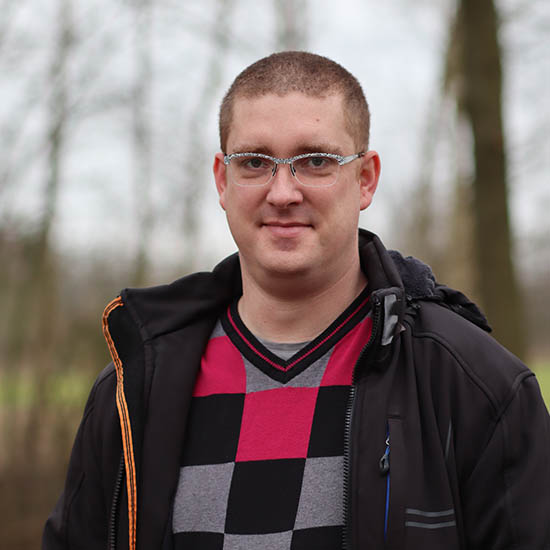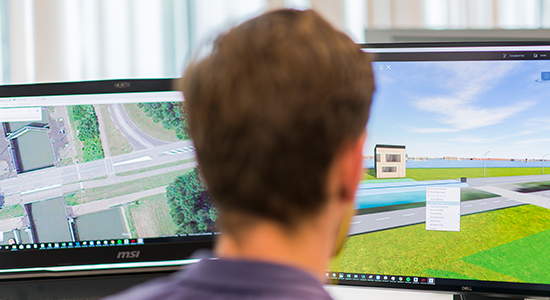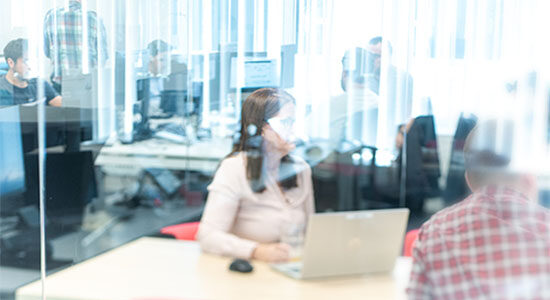Find out why the Infranea team behind the Antwerp Scheldt tunnel project is so unique
A unique team for a unique project
For Infranea, the project team has grown considerably with ten Information Engineers. The team is now bigger just for Lot 3B of the Rechteroever River (this includes the R1 Noord ring road and channel tunnels), which is the other project that Infranea is involved in for the Oosterweel connection (read more about that project here). This increase was necessary because different disciplines are needed in one assignment: Elisa and Sasja work on 3D modelling, Cesar and Marius produce the 2D plans, Sander does quality control and testing of the plans, Cedric does the 4D coordination, Mark does the coordination of all technical installations, Hassan also worked on 3D modelling, Jens did the automation (and is now continuing his work on the Rechteroever), and Yannick, as project leader and BIM coordinator Civil, is responsible for model checking and clash control, among other things. All of Infranea’s disciplines are represented except for the VR team, which was not called in for this assignment.
The team is really unique because they have developed a close bond. For example, they make time for each other to listen to how everyone is doing, including on the home front. This is greatly appreciated when teleworking is compulsory. Elisa works from Spain. So, it was important that she could first work in the Belgian office for a while and could build up a relationship with her colleagues. Sander adds that everyone has the same mindset and shares the same passion for Information Engineering. This makes it really easy to work together as a team.
Cedric adds that it is important to spend time together during lunch or free moments and get to know each other. During the project, two colleagues were allowed to start on a new project. The team courteously thanked these colleagues for their work and bid them adieu. “That connection between the team members makes us a unique team,” concluded Cedric. Yannick confirmed, “A colleague who brings something to eat makes a small gesture but that creates a bond and it clicks”.
Technology makes a lot possible, but people make the difference.
At the start of the Infranea project in August 2020, the project team regularly worked together in the Antwerp office. However, in October, there was another lockdown in Belgium. Everyone had to work from home again. Although the team of Information Engineers is familiar with teleworking, it still took them some getting used to working together from three different countries. (ed. the Netherlands, Belgium, and Spain).
“We’re familiar with teleworking, of course, but the challenge was to get the whole team sufficiently involved in the common goal,” said project leader Yannick. Thanks to solutions, such as Microsoft Teams and BIM 360, the switch to mandatory teleworking went smoothly. “You make the difference by motivating your team members,” explained Yannick. “You can feel whether everyone wants to achieve the same goal. You create a bond by keeping everyone well informed about the progress of the work and having everyone pointing in the same direction.”
Cedric mentioned that being forced to work from home made no difference to him. He did miss the car journey to the office. “It’s often a moment to disconnect and switch from work to relaxation mode,” said Cedric.
Marius misses the personal contact with colleagues in the office. His preference is to return as soon as possible to the office each day. For Sander, the combination of work from home and office work works best, “but don’t give me five days at the office because then you have too many meetings and small talk… I can be more productive at home”.
Everyone clearly has their preferences for all sorts of reasons. Which is why Infranea allows you to work the way you prefer… telework, at the office, or a hybrid working style. It’s all acceptable as long as the project fairs well.
The challenge of the Scheldt tunnel project
The Scheldt Tunnel is the most important part of the Oosterweel connection and provides the Antwerp Ring Road with a connection to the north side (read more about the project). The tunnel length is 1.8 km and it is being built using the ‘immersed tunnel’ method. Eight tunnel elements of approximately 60,000 tonnes each will be built in the inner port of Zeebrugge and then towed to Antwerp via the North Sea and the Western Scheldt. There, they will be immersed one after the other in a previously dredged trench in the Scheldt.
Sander explained that the biggest challenge is to model the tunnel elements in two different geographical locations. This is new for Infranea and caused some problems in the software. We found solutions and learned a lot from them. “We made it work,” he said proudly.
Another challenge is the flow of information. Infranea depends on data from other companies for modelling. Meeting deadlines has us on tenterhooks when there is a delay. Mark confirmed that it was not always easy to have the right data available on time for the technical installations.
If the revision of the drawings is approved by the end of April, it will be an important milestone for the team. Work on the site can then start as well as the construction of the first tunnel elements in Zeebrugge. After that, the Infranea team will be reduced in size and play a limited role in the rest of this part of the project.
The team has gained a lot of experience
Yannick explained that Infranea does not like to repeat work. In this project, there are a total of eight tunnel elements each with eight parts. That means making the same basic drawing 64 times! That is why Jens started to automate the routine parts. Thanks to that work, several dimensioned sections are already directly within the model. “There’s still some repetitive work, but only the most complex aspects need to be modelled manually,” says Yannick.
For this project, a lot of software was used altogether and that combination was quite unique. Dynamo was used to add automation. That software was new to some in the team, at least not at this scale. Also, the volume of scripting was new to some. My colleague Jens has connected up a massive number of cubes and functions on an infinitely large field and made them interact. Apparently, one of Infranea’s major strengths is being able to do this on such a scale and with such quality in-house.
“We also learn from each other as everyone brings their experience from other projects,” said Sasja. This makes the team unique as a combination and also much smarter as individuals. For Cedric, the experience with 4D was very enriching. He can now do this in other projects. He better understands how 4D works and how it can also be used for 3D applications.
“At Infranea, people sometimes say that we do not ‘use’ software but ‘abuse’ it,” laughed Cedric. “By this, we mean that we’re exploring the limits of what you can achieve with software, such as Revit, Navisworks, or Dynamo. There’s no such thing as all-in-one software that can do everything,” explained Yannick. “So we combine different software then get the most out of it.” “Any BIM company can use that combination of software, but it’s the combination of people and their specific skills that make exceptional results possible. That makes it unique and fun to work at Infranea,” concluded Yannick.
Collaboration in practice
Once a week, an online team meeting takes place where the action items, planning, and any obstacles are discussed. The platform we use for this is Microsoft Teams. “We talk to each other a lot. If a problem arises, no one hesitates to talk to a colleague or to find a solution together with the team,” added Cesar.

(c.) Cesar and Elisa are working together on the Oosterweel connection from the office in Valencia.
The conversation revealed that all team members have studied civil engineering, and in that respect, there is apparently little difference between Belgium, the Netherlands, and Spain. The differences are more in the way of working. According to Sander, they are much more guidelines in the Netherlands and rules than in Belgium. So in Belgium, he said, there is more freedom to do his job. There is also a generational difference. Some clients still want to look at plans in PDF and even on paper, while others are comfortable with digital drawings.
Apparently, it is normal for Infranea’s Information Engineers to occasionally think up solutions in their spare time because they are so passionate about their profession and the possibilities the software offers. “We don’t see any problems, only challenges,” added Yannick. “If something works, we want to see how we can make it work even better.” That sums up the mindset of the Information Engineers at Infranea.
A tip for candidates who want to work for Infranea: “Don’t come here if you’re looking for a routine job. Make it better, simpler, and faster, that’s the focus of every team at Infranea,” laughed Yannick.
The future for this team
After completion of this project, some will start working on Lot 3B of the Rechteroever, the other project Infranea is involved in for the Oosterweel connection. If possible, people get a project in their own country so they can work closer to home. That is also where Infranea makes a difference. You are not just put on a project. There is a lot of discussion as a group trying to fit the puzzle together as well as possible for everyone. So it does not matter in which team and with which colleagues you will work because next time you will once again be working with different colleagues. So there are no fixed groups and that makes the work more varied and thus also more fun.
The entire team is looking forward to going to Zeebrugge to see how the first tunnel element is made and also the sinking of the first tunnel element afterwards. “It’ll be fascinating to see our work and how big it is in reality,” said Yannick. “It’s always special because it looks so small on our screen and then so big in real life.”
Cedric confirms that he often looks at that small element on his computer screen and then sees the pictures in real life where it is taller than two metres. It is impressive. For Marius, it is an honour to work on such large infrastructure projects in Europe. It motivates him. The other team members confirm this. “It’s visible, it’s useful, and makes it satisfying. This kind of mega-project is why we chose this type of work,” said Sander.
“This project for the Oosterweel connection is so large that it could be broadcast as a documentary on the Discovery Channel,” laughed Cedric.
- Infranea has been working for Combinatie Oosterweel Tunnel COTU since the tender phase began in 2017. BESIX, DEME, Jan de Nul, and BAM Contractors together form the consortium. The principal LANTIS subcontracted out the project in an Engineering and Construct (E&C) contract with a value of 570 million euros. Infranea takes care of the BIM-Coordination Civil, 4D Planning, BIM Coordination with assistant contractor VTTI, BIM Modelling of the immersed tunnel, Scripted modelling of the tunnel and the semi-automated production of formwork plans for the immersed tunnel.

You can feel whether everyone wants to achieve the same goal. You create a bond by keeping everyone well informed about the progress of the work and having everyone pointing in the same direction.
Yannick Lens, BIM Coördinator
05/04/2022



